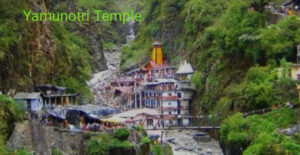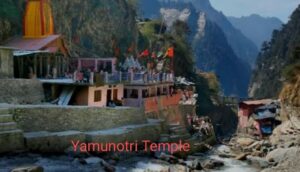Nestled in the serene Garhwal Himalayas of Uttarakhand, Yamunotri Temple is one of the most revered pilgrimage destinations in India. Dedicated to Goddess Yamuna, this temple marks the source of the Yamuna River, which holds immense religious significance in Hinduism. Thousands of devotees undertake the challenging journey to visit Yamunotri every year as part of the Char Dham Yatra, one of the most sacred pilgrimages in India, which also includes Gangotri, Kedarnath, and Badrinath. The temple is not just a religious site but also a haven for nature lovers, as it offers breathtaking views of the surrounding mountains and glaciers.

1. The Mythological Significance of Yamunotri Temple
Yamunotri Temple is steeped in Hindu mythology. According to legend, the temple is dedicated to Goddess Yamuna, the daughter of the Sun God Surya and the sister of Yama, the God of Death. It is believed that bathing in the waters of the Yamuna River absolves devotees of their sins and protects them from untimely death, a boon from her brother, Yama. The temple also has connections with Sage Asit Muni, who is said to have spent his last days near Yamunotri. His devotion to both Ganga and Yamuna is still remembered, and Yamunotri is considered as a part of his divine connection. These legends add to the temple’s spiritual significance, making it a sacred spot for Hindu devotees.
2. Yamunotri Temple: Historical and Architectural Overview
Yamunotri Temple has a rich history that dates back to the 19th century when it was constructed by Maharani Guleria of Jaipur. Although the temple has been renovated several times due to damage caused by natural calamities, its architectural design has retained a sense of simplicity and reverence. The temple is modest in its structure, made of granite stones, which blend with the natural surroundings of the Himalayas. The most striking feature of the temple is the black marble idol of Goddess Yamuna, adorned with garlands and worshipped by devotees. Despite its humble size, the temple emanates a powerful spiritual energy that attracts pilgrims from all over the country.
3. How to Reach Yamunotri Temple
Reaching Yamunotri Temple is an adventure in itself. The nearest airport is Jolly Grant Airport in Dehradun, located about 210 km away, while the nearest railway station is in Rishikesh, approximately 200 km from Yamunotri. From these points, travelers can hire taxis or take buses to reach the town of Janki Chatti, the base camp for the Yamunotri trek. The final leg of the journey involves a 6 km trek from Janki Chatti to Yamunotri, which is accessible only on foot, or via ponies and palanquins for those who need assistance. The trek, though challenging, offers stunning views of snow-capped peaks, gushing rivers, and dense forests, making the journey as spiritually rewarding as the destination.
4. The Yamunotri Trek: A Pilgrim’s Journey
The trek from Janki Chatti to Yamunotri is a significant part of the pilgrimage experience. Covering approximately 6 km, the trek takes you through scenic landscapes that are both physically and spiritually invigorating. The trail is moderately difficult, with well-paved paths, but it can be strenuous for some due to the steep ascent. Along the way, trekkers can stop at Hanuman Chatti, a small village with beautiful views and religious significance. Devotees can also take in the mesmerizing sight of Surya Kund, a hot water spring, and Divya Shila, a rock pillar considered sacred by pilgrims. This journey allows pilgrims to experience not only the beauty of the Himalayas but also the peace and tranquility that come from walking in the footsteps of countless devotees who have made the same journey over the centuries.

5. Hot Springs of Yamunotri: Surya Kund
One of the most fascinating features of Yamunotri Temple is the presence of natural hot springs, the most famous of which is Surya Kund. This geothermal spring has a temperature of around 88°C, and it plays a key role in the temple’s religious rituals. Pilgrims often cook rice and potatoes by immersing them in the hot spring, which they later offer to the goddess and take home as prasad (blessed food). Surya Kund holds special significance in Hindu mythology as it is associated with the Sun God Surya, the father of Goddess Yamuna. The steaming waters of the spring, surrounded by the cold air of the Himalayas, create an awe-inspiring contrast and provide a moment of spiritual reflection for visitors.
6. Best Time to Visit Yamunotri Temple
The best time to visit Yamunotri Temple is during the summer months from May to October. The temple remains closed during the harsh winter season when the region is blanketed in snow, and the deity is moved to her winter home in Kharsali village. The temple opens in late April or early May on the auspicious occasion of Akshaya Tritiya, and the opening ceremony is a grand event marked by prayers and celebrations. The weather during the pilgrimage season is pleasant, although it can get chilly, especially in the evenings. Monsoon months should be avoided as heavy rains can make the trek dangerous due to landslides and slippery paths. The closing day of the temple, typically on Diwali, is another special occasion when devotees gather to offer their prayers before the temple doors close for the winter.
7. Nearby Attractions and Other Religious Sites
While visiting Yamunotri, pilgrims can explore other nearby religious sites and attractions. Gangotri Temple, another significant destination on the Char Dham Yatra, is located a few hundred kilometers away and is dedicated to Goddess Ganga, the Yamuna’s sister. Kharsali Village, the winter seat of Goddess Yamuna, is a short distance from Yamunotri and is worth a visit to experience the rustic charm of this Himalayan settlement. Other attractions include Janki Chatti, known for its natural hot springs, and Saptrishi Kund, a glacial lake believed to be the actual source of the Yamuna River. For those seeking a complete spiritual experience, these additional sites enhance the sacredness of the journey.
8. Accommodations and Travel Tips
Pilgrims visiting Yamunotri have several accommodation options in nearby towns like Janki Chatti, Barkot, and Uttarkashi. Basic guesthouses and ashrams provide affordable and comfortable lodging, but it’s advisable to book in advance during the peak pilgrimage season. It’s essential to pack light but include warm clothing, sturdy trekking shoes, and rain gear for the unpredictable mountain weather. Altitude sickness can affect some visitors, so acclimatization is recommended, especially for those who are not used to high altitudes. It’s also important to carry snacks, water, and essential medications, as there are limited facilities along the trekking route. Being well-prepared will ensure a smooth and enjoyable pilgrimage.
9. The Spiritual Essence of Yamunotri Temple
The journey to Yamunotri Temple is not just a physical trek; it is a spiritual experience that connects pilgrims with their faith, nature, and the divine. The temple, surrounded by the majestic Himalayas and flowing rivers, offers a serene environment for meditation and prayer. The journey itself is symbolic of the challenges one faces in life, with the ultimate goal of spiritual enlightenment. For many, the pilgrimage to Yamunotri is a transformative experience, providing a deep sense of peace, fulfillment, and connection to the divine forces that shape the universe.
Conclusion:
Yamunotri Temple stands as a symbol of faith, devotion, and the timeless bond between humanity and nature. A visit to this sacred site offers not only spiritual rewards but also a chance to experience the stunning beauty of the Himalayas. Whether you are seeking spiritual solace or simply want to witness the awe-inspiring landscapes of Uttarakhand, Yamunotri Temple should be on your travel list. Undertaking the pilgrimage to Yamunotri is not just about reaching the temple but embracing the journey and the divine energy that surrounds it.
FAQ:
1.What is special about Yamunotri temple?
2.Which god is Yamunotri?
3.Is Yamunotri trek difficult?
4.How long does Yamunotri trek take?
5.Yamunotri temple built by
6.Yamunotri temple height
7.Yamunotri Yatra
8.Yamunotri temple inside
9.Yamunotri temple History in marathi
10.Yamunotri Temple opening date 2024

